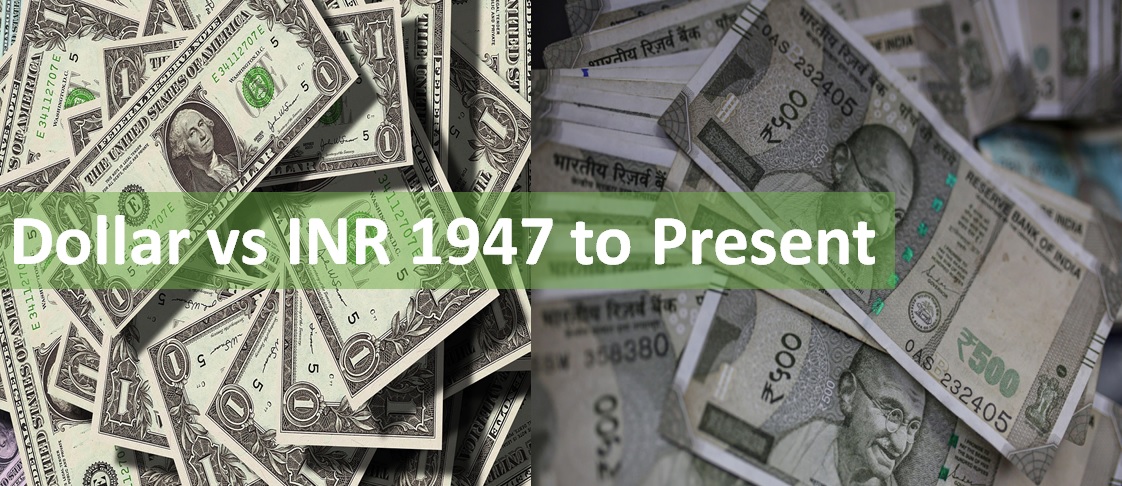Dollar vs INR 1947 to Present – Understanding the Factors Influencing the Dollar-INR Exchange Rate Over the Decades

We all know the United States Dollar (USD) is one of the most powerful currencies in the world. It is also the World’s most widely used currency. The journey of Indian National Rupees (INR) comparison with USD has been a fascinating one. The exchange rate between both currencies has gone through a large number of changes.
India gained its independence in 1947. At that time, one US dollar was less than 4 Indian rupees. Now, in 2023, 1 US dollar can give you more than 83 Indian rupees. Understanding the history and the factors that have influenced this exchange rate can provide valuable information about the economic growth, and political events that have transformed both India and the US.
1 USD to Indian National Rupees (INR) in 1947 to 2023
Check out the following table to understand fluctuations of the 1 USD to 1 INR Exchange Rate from 1947 to the present.
| Year | Price 1 USD in INR |
| 1947 | Rs. 3.30 |
| 1949 | Rs. 4.76 |
| 1966 | Rs. 7.50 |
| 1975 | Rs. 8.39 |
| 1980 | Rs. 7.86 |
| 1985 | Rs. 12.38 |
| 1990 | Rs. 17.01 |
| 1995 | Rs. 32.42 |
| 2000 | Rs. 43.50 |
| 2005 (January) | Rs. 43.47 |
| 2006 (January) | Rs. 45.19 |
| 2007 (January) | Rs. 39.42 |
| 2008 (October) | Rs. 48.88 |
| 2009 (October) | Rs. 46.37 |
| 2010 (January) | Rs. 46.21 |
| 2011 (April) | Rs. 44.17 |
| 2011 (September) | Rs. 48.24 |
| 2011 (November) | Rs. 55.39 |
| 2012 (June) | Rs. 57.15 |
| 2013 (May) | Rs. 54.73 |
| 2013 (September) | Rs. 62.92 |
| 2014 (May) | Rs. 59.44 |
| 2014 (September) | Rs. 60.95 |
| 2015 (April) | Rs. 62.30 |
| 2015 (May) | Rs. 64.22 |
| 2015 (September) | Rs. 65.87 |
| 2015 (November) | Rs. 66.79 |
| 2016 (20th January) | Rs. 68.01 |
| 2016 (25th January) | Rs. 67.63 |
| 2016 (February) | Rs. 68.82 |
| 2016 (April) | Rs. 66.56 |
| 2016 (September) | Rs. 67.02 |
| 2016 (November) | Rs. 67.63 |
| 2017 (March) | Rs. 65.04 |
| 2017 (April) | Rs. 64.27 |
| 2017 (May) | Rs. 64.05 |
| 2017 (August) | Rs. 64.13 |
| 2017 (October) | Rs. 64.94 |
| 2018 (May) | Rs. 64.80 |
| 2018 (October) | Rs. 74.00 |
| 2019 (October) | Rs. 70.85 |
| 2020 (January) | Rs. 70.96 |
| 2020 (December) | Rs. 73.78 |
| 2021 (January) | Rs. 73.78 |
| 2021 (December) | Rs. 73.78 |
| 2022 (January) | Rs. 75.50 |
| 2022 (December) | Rs. 81.32 |
| 2023 (January) | Rs. 82.81 |
| 2023 (June) | Rs. 83.94 |
| 2023 (October) | Rs. 83.17 |
History of United States Dollars (USD) to Indian National Rupees (INR) Exchange Rate
As you can see, in the early years, the exchange rate was relatively stable, with 1 USD being equivalent to around 4 INR. However, in the later years, various economic factors and global events caused fluctuations in the exchange rate.
The value of Indian Rupees depreciated significantly due to factors such as the Indo-China war, Indo-Pak war, national emergency, etc. In the 1990s, India worked on economic reforms and moved toward liberalisation by opening up its markets for companies around the globe. Check National Symbols of India
This resulted in increased foreign investments in India. A surge in the value of the Indian rupee was also observed during this time. By the early 2000s, 1 USD was equivalent to only about 45 INR. However, the global financial crisis of 2008 had a significant impact on currencies worldwide.
Today, in 2023, the value of 1 USD is around Rs. 83.17. If we look at the trend in the past few years, we can say that the value of INR is decreasing and the US Dollar is getting stronger and stronger.
Significant Events Resulted in the Devaluation of the Indian Rupee as Compared to the USD
Here is a list of some economic decisions and events in India that resulted in the Indian rupee becoming weak if we compare it with the USD.
| Events | Year | Explanation |
| Decimalisation | 1957 | India introduced a new currency system. It divided one rupee into 100 paise. It doesn’t directly impact the value of rupees with Dollars. However, it was one of the major economic decisions in India. |
| 1966 economic crises | 1966 | India faced this economic crisis because it was importing way more than exporting. It caused the value of the Rupee to decrease compared to the US Dollar. |
| Wars with China and Pakistan | 1962, 1965, and 1971 | Due to various border issues, India went to war with China in 1962 and with Pakistan in 1965 & 1971. During times of these wars, India spent a lot of money on defence and other related things. This led to a decrease in the value of the currency. |
| 1991 Economic Crisis | 1991 | India faced yet another economic crisis in 1991. This time, due to low foreign reserves. The Indian government had to devalue the Rupee once again. This helped increase exports but made imported goods costlier. |
| Demonetization | 2016 | At the time of Demonetization, the government of India declared Rs. 500 and Rs. 1000 notes invalid to tackle corruption. However, it caused some difficulties in the economy. The value of the Rupee was affected during this period. |
Factors Affecting Dollars to Rupees Exchange Rate
A large number of factors contributed to the fact that the Indian Rupee is losing its value against the US Dollar. We have listed a few of these factors below.
Historical monuments printed on Indian Currency
Trade Deficit
The trade balance between India and the US favours the USA. It means the US enjoys a trade surplus (more exports than imports against India). Over the years, this has resulted in the strengthening of USD against INR.
Demand and Supply
The basic Demand and Supply rule of economics also applies here. If more people want to buy Rupees with their Dollars then the value of Rupees will go up. Similarly, in case more people will look to buy Dollars with rupees then the value of Rupees will go down.
Inflation
If a country is dealing with inflation then the value of its currency will go down. Unfortunately, India along with many other South-Asian countries is dealing with a high inflation rate. This has resulted in the value of the Indian rupee going down as compared to the United States Dollar.
Economic Condition and Stability
According to many experts, the economic stability of a country is another factor that influences the value of its currency. In this case, the United States is one of the most stable countries in the world. So, many more people want to invest in Dollars as compared to rupees.
Also Check Top 10 Highest Currencies in the World
Frequently Asked Questions
No, as per the records, 1 INR was never equal to 1 USD.
Answer.
India
In the US, the maximum personal income tax rate is 51.6%. On the other hand, it is only 30% in India.
Industries that export their goods and services get the benefit of a weak rupee. These industries include IT, Metal, Pharma, and more.
18 countries




